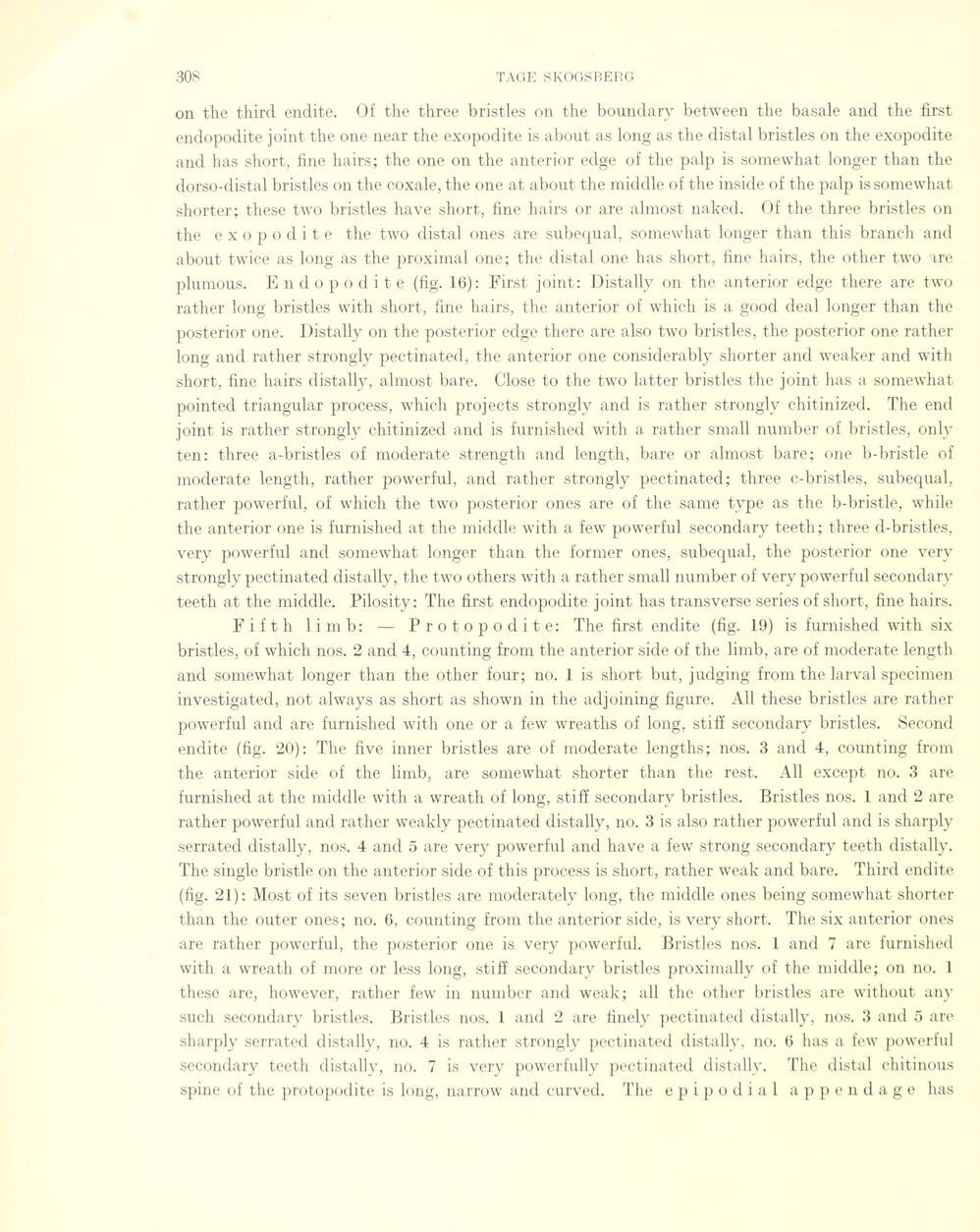
Full resolution (JPEG) - On this page / på denna sida - Sidor ...

<< prev. page << föreg. sida << >> nästa sida >> next page >>
Below is the raw OCR text
from the above scanned image.
Do you see an error? Proofread the page now!
Här nedan syns maskintolkade texten från faksimilbilden ovan.
Ser du något fel? Korrekturläs sidan nu!
This page has never been proofread. / Denna sida har aldrig korrekturlästs.
on the third endite. Of the three bristles on the boundary between the basale and the first
endopodite joint the one near the exopodite is about as long as the distal bristles on the exopodite
and has short, fine hairs; the one on the anterior edge of the palp is somewhat longer than the
dorso-distal bristles on the coxale, the one at about the middle of the inside of the palp is somewhat
sliorter; these two bristles have short, fine hairs or are almost naked. Of the three bristles on
the exopodite the two distal ones are subequal, somewhat longer than this branch and
about twice as long as the proximal one; the distal one has short, fine hairs, the other two are
plumous. Endopodite (fig. 16): First joint: Distally on the anterior edge there are two
rather long bristles with short, fine hairs, the anterior of which is a good deal longer than the
posterior one. Distally on the posterior edge there are also two bristles, the posterior one rather
long and rather strongly pectinated, the anterior one considerably shorter and weaker and with
short, fine hairs distally, almost bare. Glose to the two latter bristles the joint has a somewhat
pointed triangulär process, which projects strongly and is rather strongly chitinized. The end
joint is rather strongly chitinized and is furnished with a rather small number of bristles, only
ten: three a-bristles of moderate strength and length, bare or almost bare; one b-bristle of
moderate length, rather powerful, and rather strongly pectinated; three c-bristles, subequal,
rather powerful, of which the two posterior ones are of the same type as the b-bristle, while
the anterior one is furnished at the middle with a few powerful secondary teeth ; three d-bristles,
very powerful and somewhat longer than the former ones, subequal, the posterior one very
strongly pectinated distally, the two others with a rather small number of very powerful secondary
teeth at the middle. Pilosity : The first endopodite joint has transverse series of short, fine hairs.
Fifth limb: — Protopodite: The first endite (fig. 19) is furnished with six
bristles, of which nos. 2 and 4, counting from the anterior side of the limb, are of moderate length
and somewhat longer than the other four; no. 1 is short but, judging from the larval specimen
investiga ted, not always as short as shown in the adjoining figure. All these bristles are rather
powerful and are furnished with one or a few wreaths of long, sti ff secondary bristles. Second
endite (fig. 20): The five inner bristles are of moderate lengths; nos. 3 and 4, counting from
the anterior side of the limb, are somewhat shorter than the rest. All except no. 3 are
furnished at the middle with a wreath of long, sti ff secondary bristles. Bristles nos. 1 and 2 are
rather powerful and rather weakly pectinated distally, no. 3 is also rather powerful and is sharply
serrated distally, nos. 4 and 5 are very powerful and have a few strong secondary teeth distally.
The single bristle on the anterior side of this process is short, rather weak and bare. Third endite
(fig. 21): Most of its seven bristles are moderately long, the middle ones being somewhat shorter
than the outer ones; no. 6, counting from the anterior side, is very short. The six anterior ones
are rather powerful, the posterior one is very powerful. Bristles nos. 1 and 7 are furnished
with a wreath of more or less long, stiff secondary bristles proximally of the middle; on no. 1
these are, however, rather few in number and weak; all the other bristles are without any
such secondary bristles. Bristles nos. 1 and 2 are finely pectinated distally, nos. 3 and 5 are
sharply serrated distally, no. 4 is rather strongly pectinated distally, no. 6 has a few powerful
secondary teeth distally, no. 7 is very powerfully pectinated distally. The distal chitinous
spine of the protopodite is long, narrow and curved. The epipodial appendage has
<< prev. page << föreg. sida << >> nästa sida >> next page >>